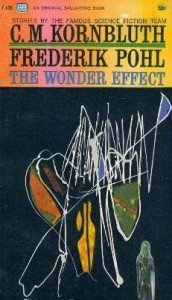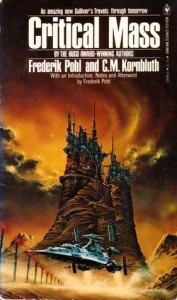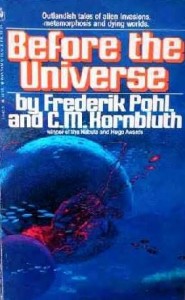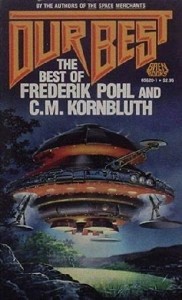Return to Introduction
Return to The Space Merchants
Return to Search the Sky
Return to Two Solo Novels: The Syndic and Drunkard’s Walk
Return to Gladiator-at-Law
Although best known for their quartet of science fiction novels they published in collaboration, the partnership of Frederik Pohl and Cyril Kornbluth also produced about thirty-five short stories. These stories can be divided into three groups. The bulk of them (many now lost, or buried within one of the numerous pseudonyms the Futurians used during their early writing days) were written between 1939, when Cyril was 17 and Fred was 21, and 1943, when they both entered the U.S. Army. They produced an additional handful during the years between their collaborations on The Space Merchants in 1952 and Wolfbane in 1957. Following Kornbluth’s death on March 21, 1958, Pohl went through an assortment of manuscripts, both stories and a couple of unfinished novels, that his former writing partner had left incomplete, and over a period of about fifteen years expanded several of those fragments into complete stories. He also revised some of their earliest shared work together, pieces they had written in collaboration during the late 1930s or early 1940s and which had gotten temporarily lost.
Four collections of their collaborative short fiction have been published. The contents of each overlap a good bit, as you can see below (h/t: Wikipedia entry on Cyril Kornbluth):
The Wonder Effect (1962)
“Introduction,”
“Critical Mass,” 1962
“A Gentle Dying,” 1961
“Nightmare with Zeppelins,” 1958
“Best Friend” [as by S. D. Gottesman], 1941
“The World of Myrion Flowers,” 1961
“Trouble in Time” [as by S. D. Gottesman], 1940
“The Engineer,” 1956
“Mars-Tube [as by S. D. Gottesman],” 1941
“The Quaker Cannon,” 1961
Critical Mass (1977)
“Introduction,” (Pohl)
“The Quaker Cannon,” 1961
“Mute Inglorious Tam,” 1974
“The World of Myrion Flowers,” 1961
“The Gift of Garigolli,” 1974
“A Gentle Dying,” 1961
“A Hint of Henbane,” 1961
“The Meeting,” 1972
“The Engineer,” 1956
“Nightmare with Zeppelins,” 1958
“Critical Mass,” 1962
“Afterword,” (Pohl)
Before the Universe (1980)
“Introduction,” (Pohl)
“Mars-Tube” [as by S. D. Gottesman], 1941
“Trouble in Time” [as by S. D. Gottesman], 1940
“Vacant World” [as by Dirk Wylie (with Dirk Wylie and Pohl)], 1940
“Best Friend” [as by S. D. Gottesman], 1941
“Before the Universe” [as by S. D. Gottesman], 1939
“Nova Midplane” [as by S. D. Gottesman], 1940
“The Extrapolated Dimwit” [as by S. D. Gottesman], 1942
“Afterword,” (Pohl)
Our Best: The Best of Frederik Pohl and C.M. Kornbluth (1987)
“Introduction,” (Pohl)
“The Stories of the Sixties,” (Pohl, section introduction)
“Critical Mass,” 1962
“The World of Myrion Flowers,” 1961
“The Engineer,” 1956
“A Gentle Dying,” 1961
“Nightmare with Zeppelins,” 1958
“The Quaker Cannon,” 1961
“The 60/40 Stories,” (Pohl, section introduction)
“Trouble in Time” [as by S. D. Gottesman], 1940
“Mars-Tube” [as by S. D. Gottesman], 1941
“Epilogue to The Space Merchants,” (Pohl, section introduction)
“Gravy Planet,” (extract from the magazine serial, not used in the book)
“The Final Stories,” (Pohl, section introduction)
“Mute Inglorious Tam,” 1974
“The Gift of Garigolli,” 1974
“The Meeting,” 1972
“Afterword,” (Pohl)
In his Introduction to their collection of their early collaborative stories, Before the Universe, Pohl wrote, “The first published story by Cyril and me was ‘Before the Universe.’ … We worked out an assembly line procedure: I wrote an ‘action chart’ – essentially a plot outline, with some indication of characters and setting – from which Cyril wrote a first draft, which I then revised and retyped…” He also had this to say about their early collaborations (from his Introduction to their earliest collection of shared stories, The Wonder Effect): “A number of reviewers have speculated, and readers from time to time ask, what the mechanics of collaboration were between us. I take this to condone the vanity of supplying an answer. There isn’t one single answer, though, because we tried everything. At first I made up plots, Cyril fleshed out the stories and I rewrote them in final form for publication. That was the technique that produced the bulk of the early stories which I now hope to see forgotten. I was not a very good way of writing a story, and we never wrote a complete story that way after 1942.”
Their 1980 collection, Before the Universe, contains those early stories which Frederik Pohl is willing to share with the reading public. “Before the Universe,” “Nova Midplane,” and “The Extrapolated Dimwit” form a trilogy, the best that can be said of them being that they display a pulpish energy which sweeps the reader along and that the three main characters, two male scientists and a woman reporter, banter continuously in a not-too-bad imitation of Nick and Nora Charles from The Thin Man series of books and films, or the screwball comedies popular in the 1930s. I think the most enjoyable is the last, “The Extrapolated Dimwit,” wherein Pohl and Kornbluth shared the writing chores with fellow Futurian Robert “Doc” Lowndes. Of the remaining stories in the volume, “Best Friend” is interesting in that it focuses on evolved, intelligent dogs, a notion explored to great effect in the later stories of Cordwainer Smith. “Vacant World,” which was written in conjunction with Dirk Wylie, contains some memorable images of a seemingly abandoned Earth that wouldn’t be out of place in a Twilight Zone episode. “Mars-Tube” is probably the most technically proficient of these early stories, being an entertaining adventure story focusing on an ancient subway system beneath the surface of Mars.
Of the stories collected in the four volumes, the only one which Frederik Pohl identifies as having been completed after their military service and before Kornbluth’s death is “The Engineer,” which was a revised out-take, or unused scene, from their novel, Gladiator-at-Law, focusing on a character, a “political engineer” (in the same sense that Dwight Eisenhower was considered a “political general”) who does not appear in published versions of the novel. All of the other stories in The Wonder Effect, Critical Mass, and Our Best, with the exception of those stories these collections share with Before the Universe, were posthumous collaborations, where Pohl took up an incomplete story or fragment of a novel Kornbluth had left behind (or, in the case of “A Gentle Dying,” a pre-war collaborative story which had gotten misplaced) and expanded it into a full story, the last of which being “The Gift of Garigolli,” published sixteen years after Kornbluth’s death.
In his introduction to Critical Mass, Pohl wrote, “I think if Cyril had lived he would have become one of the all-time greats of the field. He was just hitting his stride when his health began to falter. … When the Army made him a machine-gunner, lugging a 50-calibre-heavy MG around the Ardennes forest, they shortened his life. Exertions damaged his heart, and in his midthirties his doctor told him that he had a clear choice. He could give up smoking, drinking, spices in his food, a lot of the food itself, irregular hours and excitement; or he could die of hypertension.”
Kornbluth followed his doctor’s advice for nearly a year, cutting virtually all his former pleasures out of his life and going on the primitive tranquilizers of the 1950s, which had the effect of making him sluggish and thick-headed and also making it impossible for him to write. Pohl continues: “So I suppose Cyril made his choice. In his place, I think I might have made the same one. He went back to coffee and cigarettes, gave up the medication, went back to writing, finished the revisions on Wolfbane, wrote two or three of his best novelettes, signed on as an editor for The Magazine of Fantasy and Science Fiction — his first experiment with editing, rather than writing, science fiction, and one which he enjoyed enormously. … And then on a snowy March morning I had a phone call from Mary, his wife, to say that Cyril had shoveled out their driveway to free his car, run to catch a train and dropped dead on the station platform.
“He left a bundle of incomplete manuscripts and fragments, some of which I was later able to revise and complete…”
One of the posthumous collaborations, “The Meeting,” was awarded a Hugo in 1973, the only Hugo Award Cyril Kornbluth would receive (he completed virtually all of his work before the Hugo Awards were established, although one of his best solo stories, “The Little Black Bag,” and one of his most memorable novellas, “The Marching Morons,” were selected by Robert Silverberg for The Science Fiction Hall of Fame, a trio of volumes assembled by the Science Fiction and Fantasy Writers of America to commemorate the finest short fiction to be published prior to 1965, too early to have been nominated for a Nebula Award). “The Meeting” is a very low-key story which centers on a subject very near Cyril Kornbluth’s heart — the plight of “exceptional children,” sufferers of autism or severe emotional-neurological impairments — that ends with a punch to the reader’s gut, subtle and powerful. Nearly as good is “Mute Inglorious Tam,” which isn’t a science fiction story at all, but rather a story about story-telling and the making of science fiction; it centers on a peasant in Medieval England who, had he lived in a less brutal and hand-to-mouth age, perhaps five centuries later, would have become a science fiction writer but who is trapped by the constraints of his time. I also really enjoyed “The Quaker Cannon,” which benefits from both writers’ years in the military, and “Nightmare with Zeppelins,” a proto-Steampunk story centering on the discovery of the secret of atomic power deep within the colonial Africa of the Victorian Age, a story which Frederik Pohl expanded from fragments of an unfinished novel about the Civil War’s Battle of the Crater which Kornbluth had been unable to complete. “Critical Mass” is noteworthy in that Pohl expanded it from three separate story fragments Kornbluth had left behind, plus an additional story fragment of Pohl’s own — four fragments in all.
In all honesty, I have to say that very few of the stories in these four collections approach the quality of the best of Cyril Kornbluth’s solo short fiction or the best of Frederik Pohl’s. Clearly, working at novel-length was a more appropriate venue within which their collaborative genius could shine. Also, the stories that have come down to us are either products of their earliest, youngest writing days or represent Frederik Pohl’s attempts, some more successful than others, at resurrecting the ashes of stories left undone. However, the lengths Pohl was willing to go over a fifteen year span to utilize virtually every usable scrap of prose Cyril Kornbluth left behind is a testimony to his enormous respect for the skills of his former partner and his desire that Cyril Kornbluth’s name should live on for readers of science fiction. As he wrote in the Afterword to Critical Mass, “Some person who is not me will have to decide how great a writer Cyril Kornbluth was. I was too close to him, as collaborator in many ways, and as friend.”
Next: Wolfbane








